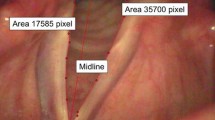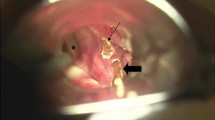Abstract
Our aim was to obtain an objective evaluation of the airway before and after reversible glottis-dilating operations using the lung function test. Bilateral abductor vocal cord paralysis remains mostly a complication of thyroid surgery. After thyroid surgery, the paralysis is potentially reversible, and the patient has a chance for recovery mostly in the first 6 months. According to these considerations, a reversible vocal cord laterofixation procedure was used instead of tracheostomy. The operations were performed endoscopically using high-frequency JET ventilation and the special endo-extralaryngeal suture technique by Lichtenberger. This technique was used in 92 cases. The pre- and postoperative data of reversible glottis-dilating techniques could be compared in 23 non-selected patients. Lung function tests that were performed were forced inspiratory volume (FIV1), forced expiratory volume (FEV1), peak inspiratory flow rate (PIF), peak expiratory flow rate (PEF) and resistance of the airways (Raw). For the evaluation of the functional results, we used the body-pletysmograph. Our aim was to obtain a quantitative evaluation of the results. These values allow us to compare the results achieved by using different glottis-dilating methods. The FEV1 (forced expiratory volume) improved 25%, and the FIV1 (forced inspiratory volume) improved 39% after the operations on average. PEF (peak expiratory flow rate) and PIF (peak inspiratory flow rate) improved 37 and 45% after glottis-dilating surgery on average. The Raw (resistence of airways) was 271.5% on average before the operations, and after reversible glottis-dilating operations decreased to a level of 200.6%.








Similar content being viewed by others
References
Lichtenberger G (1983) Endo-extralaryngeal needle carrier instrument. Laryngoscope 93:1348–1350
Woodson BT, McFadden EA, Toohill RJ (1991) Clinical experience with the Lichtenberger endo-extralaryngeal needle carrier. Laryngoscope 101:1019–1023
Lichtenberger G, Toohill RJ (1998) Endo-extralaryngeal suture technique for endoscopic lateralisation of paralysed vocal cords. Oper Tech Otolaryngology Head Neck Surg (Chicago) 9:166–171
Lichtenberger G (1999) Reversible immediate and definitive lateralisation of paralysed vocal cords. Eur Arch Otolaryngol 256:407–411
Incze F, Lichtenberger G, Medgyesy M, Vámos Z (1984) Modifiziertes Verfahren der ohne Intubation durchgefuhrten Anaestesie bei laryngomikroskopichen Eingriffen Anaesthesist 33:276–283
Lichtenberger G, Kelemen S (1984) Möglichkeiten der chirurgishen Behandlung von Kehlkopfverengungen und pletysmograpische Objektivierung der Resultate. Laryngol Rhinol Otol 63:289–294
Lichtenberger G (2002) Reversible lateralisation of the paralyzed vocal cord without tracheostomy. Ann Otol Rhinol Laryngol 111:21–26
Werner JA, Lippert BM (2002) Laterofixation der Stimmlippe statt Tracheotomie bei akuter beidseitiger Stimmlippenparese. Deutsche Medizinische Wochenschrift 127:917–922
Misiolek M, Namyslowski G, Warmuzinski K, Karpe J, Rauer R, Misiolek H (2003) The influence of laser arytenoidectomy on ventilation parameters in patients with bilateral vocal cord paralysis. Eur Arch Otorhinolaryngol 260:381–385
Bogaard JM, Pauw KH, VersprilleA, Stam H, Verbraak AFM, Maas AJJ (1987) Maximal expiratory and inspiratory flow-volume loop curves in bilateral vocal cord paralysis. ORL 49:35–41
Sittel C, Stennert E, Thumfart WF, Dapunt U, Eckel HE (2001) Prognostic value of laryngeal electromyography in vocal fold paralysis. Arch Otolaryngol Head Neck Surg 127:155–160
Author information
Authors and Affiliations
Corresponding author
Additional information
This paper was presented at the 4th ELS Congress in Brussels on 5–7 September 2002.
Rights and permissions
About this article
Cite this article
Leitersdorfer, S., Lichtenberger, G., Bihari, A. et al. Evaluation of the lung function test in reversible glottis-dilating operations. Eur Arch Otorhinolaryngol 262, 289–293 (2005). https://doi.org/10.1007/s00405-004-0814-0
Received:
Accepted:
Published:
Issue Date:
DOI: https://doi.org/10.1007/s00405-004-0814-0




